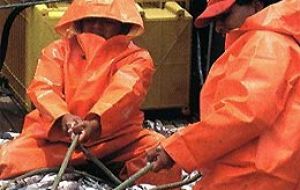MercoPress. South Atlantic News Agency
Argentine hake catches down 60% in first 42 days of 2010
 Late season start but also less juveniles among possible causes
Late season start but also less juveniles among possible causes Argentine ports received 9,246.4 tons of common hake (Merluccius hubbsi) between January 1 and February 12 this year which is 60% less than the 23,200 tons for the same period a year ago.
Of that total, 8.796,7 tons were from the southern stock and 449.7 tons from the north according to the Secretariat of Fisheries, a dependency of the Ministry of Agriculture, Livestock and Fisheries (MINAGRI).
The landings were as follows: Mar del Plata, 6,883.3 tons of hake; San Antonio Este, 1,008.7 tons; Comodoro Rivadavia, 468.6 tons, and Ushuaia, 380.2 tons. According to official data, fresh fish vessels unloaded 8,014.6 tons of common hake, and trawlers, 919.2 tons.
The Argentine fish industry estimates the reduction of total landings is due to economic and biological questions.
“Many vessels began working later than usual after the Holidays [in late 2009] and that caused a slow start” explained an operator to Pescare.
A constant increase in costs structure was registered and several shipowners waited for the price of hake to increase before setting sail, which finally happened at the end of last week.
Another reason is that common hake behaved “evasively” in the sea, which resulted in low yields and storage holds at 50% of their capacity. Additionally sources from the country’s National Institute for Fisheries Research and Development, INIDEP, unofficially revealed that during the last cruise scientists did not find much hake when assessing juveniles in the northern Patagonian breeding ground in mid-January.
In late 2009, the Argentine Federal Fisheries Council, CFP, decided a common hake total allowable catch (TAC) of 338,000 tons for 2010, which is 72.000 tons, or 27 % higher than the previous year. According to Resolution 28/09, a maximum of 290.000 tons can be extracted from the southern stock and 48,000 tons of the Northern stock.
The decision adopted by the CFP allows the fishing effort to increase by 83,000 tons on the first stock and cut back by 11,000 tons on the second, compared to this year.
Meanwhile, an investigation carried out by the oil company Pan American Energy (PAE), at the behest of the Santa Cruz Fisheries Sub-Secretariat, contends that the capture of common hake has spiked in the San Jorge Gulf fishing-ground.
The results of the study contradict claims by the yellow fleet fishers of Caleta Paula, who complain of a lesser abundance of the resource. The fishing industry insists that submarine seismic survey conducted by the company spurred a fall in the hake volume.
“The Santa Cruz Fisheries Sub-Secretariat requested a specific measure from us as far as the gulf: that we conduct a fisheries monitoring before, during and subsequent to the survey. We did so in 10 stations and compared it to the seismic one we did within the ban zone,” explained Fernando Villarreal, vice-president of Offshore Operations of Pan American Energy. (FIS)




Top Comments
Disclaimer & comment rulesCommenting for this story is now closed.
If you have a Facebook account, become a fan and comment on our Facebook Page!